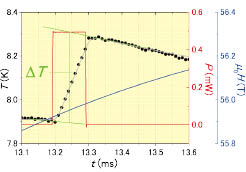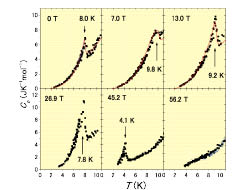Heat Pulse Measurements of Specific Heat in Pulsed Magnetic Fields
Kindo Group
Measurements of the specific heat (Cp) in magnetic fields have been widely used to investigate fundamental properties of a material. Although several attempts to provide specific heat data at high magnetic field have been made, experiments in pulsed magnets are subject to strong constrains that arise from the short timescale of the measurements. Therefore, calorimetric studies have all been limited to the magnetic field range accessible to continuous magnets (dc magnets), with very few exceptions of pulsed magnets having an unusually long (>250 ms) pulse field duration [1,2]. In this context, we have developed, for the first time, a calorimeter that can operate in short pulse duration of less than 50 ms [3].

Fig. 1. Time dependence of the temperature (black dots), the power of the heat pulse (red), and the field profile (blue) during the 36 ms pulsed magnetic field. Gray curve represents a fit obtained with a simple heat equation.

Fig. 2. A comparison of the specific heat data from the heat-pulse calorimeter (sample 1; black squares and sample 2; blue crosses) with those from the PPMS (red curves) near the phase transition in Cu3Mo2O9. Arrows indicates the peak temperature in specific heat.
We attempt to obtain a quick thermal response by reducing the physical size of the calorimeter. Our calorimeter consists of a Au16Ge84 thin-film thermometer, a Ni50Cr50 thin-film heater, 100 μm diameter Constantan relaxation wires, and a quartz thermal bath. The eliminations of a bulk thermometer and a bulk heater lead to a quick monitoring of the temperature and enable us to study thermodynamic properties, such as Cp and magnetocaloric effect (MCE), in the 36 ms pulsed magnet that is commonly used to reach fields above 50 T. As a test of our thin-film based calorimeter, we have measured the Cp of slab-shaped Cu3Mo2O9 single crystalline samples (0.10 mg (sample 1) and 0.0285 mg (sample 2)) between 3 and 20 K in pulsed magnetic fields up to ~56 T.
Figure 1 shows the time dependence of sample temperature (black curve) during a specific heat measurement in the presence of 56 T pulsed magnetic fields. During the application of square heat pulse (red curve), the sample temperature linearly increased, and immediately after the heat pulse a clear step in temperature was observed. The short time scale of measurement (~0.5 ms) significantly reduces the uncertainty in magnetic field (blue curve); 0.2% of the applied field (56.0 ± 0.1 T) for observing a single temperature step. Since the step-like temperature change is the ideal situation for the heat pulse calorimetry, the change of the temperature (ΔT) can be estimated by the linear extrapolation (green lines in Fig. 1(a)), and the ΔQ is obtained by integrating the P(t) curve. The molar specific heat was calculated by Cp = ΔQΔT-1m-1M, where m and M are the sample mass and the molar weight, respectively, and its temperature dependence was plotted in Fig. 2.
Figure 2 shows the Cp(T) of sample 1 (black dots) and sample 2 (blue crosses) in various magnetic fields are shown together with PPMS data measured at 0, 7 and 13 T. Cp(T)show λ-type pronounced peak and its peak temperature and the size of the anomaly varies as the applied magnetic field changes. Although the point-to-point scatter obtained from the present set-up is more than that of PPMS (red curve), the over-all temperature dependence of Cp, including the peak shape and its absolute value, agree well with the data measured in PPMS. We estimate that the absolute accuracy of the measurement is better than ±10% for temperature range from 3 to 20 K. The quantitative agreement between two sets of data shows that the experiment we are doing in pulsed field is the same as the experiments we have been doing in dc fields. The resultant Cp(T) data can be analyzed in the conventional way to determine the entropy, specific heat exponent, and possibly the order of the phase transition.
We have developed an effective calorimeter for use in a pulsed magnetic field up to ~56 T and tested their performance with Cu3Mo2O9 single crystalline samples. For Cu3Mo2O9, this system exhibits an overall accuracy of better than ±10% for entire temperatures range of 3 to 20 K. This technique is now open to users of International Megagauss Science Laboratory.
References
- [1] M. Jaime et al., Nature 405, 160 (2000).
- [2] Y. Kohama, C. Marcenat, T. Klein, and M. Jaime, Rev. Sci. Instrum. 81, 104902 (2010).
- [3] Y. Kohama, Y. Hashimoto, S. Katsumoto, M. Tokunaga, and K. Kindo, Meas. Sci. Technol. 24, 11505 (2013). (IOP select)
